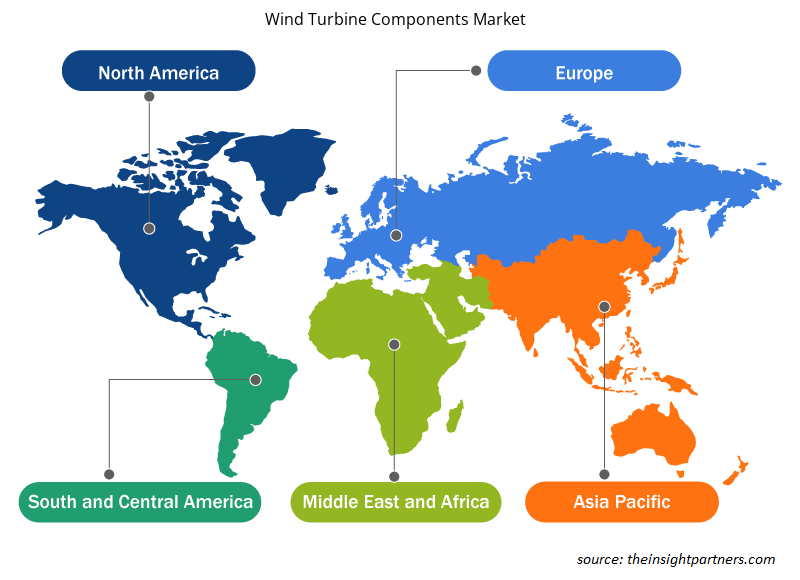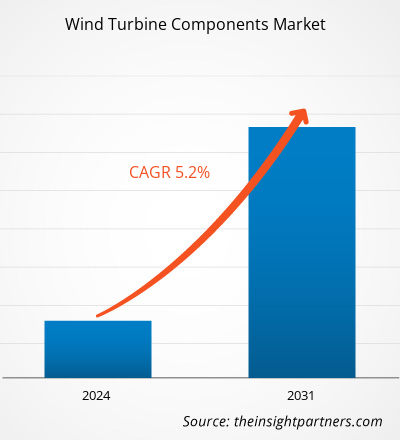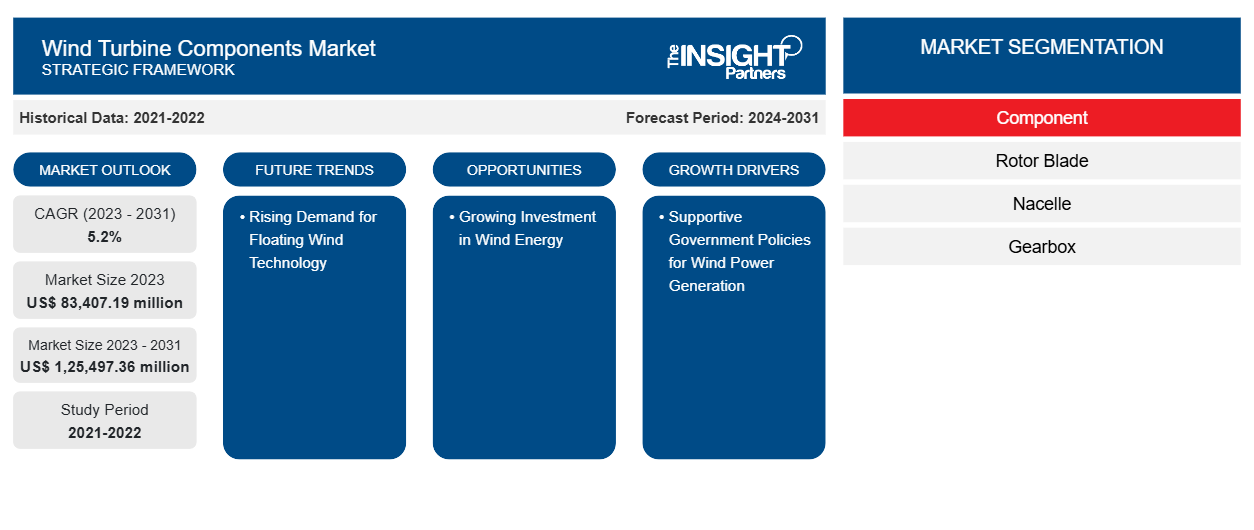Si prevede che la dimensione del mercato dei componenti delle turbine eoliche raggiungerà 1.25.497,36 milioni di dollari entro il 2031, rispetto agli 83.407,19 milioni di dollari del 2023. Si prevede che il mercato registrerà un CAGR del 5,2% nel 2023-2031. La crescente attenzione alla riduzione delle emissioni di gas serra, la crescente enfasi sulle fonti di energia rinnovabili per promuovere la sostenibilità e la crescente preoccupazione per la protezione dell'ambiente sono alcune altre tendenze per il mercato dei componenti delle turbine eoliche.
Analisi di mercato dei componenti delle turbine eoliche
La crescente espansione dei progetti di energia eolica e rinnovabile è il fattore chiave che stimola la richiesta di componenti per turbine eoliche. Le fonti di energia rinnovabile svolgono un ruolo fondamentale nel garantire energia sostenibile con emissioni ridotte. La crescente consapevolezza dell'efficienza energetica è stata incoraggiata ad aumentare l'applicazione dell'energia eolica. La crescente domanda di energia mette in mostra l'importanza delle fonti di energia eolica. Si prevede che l'aumento dei prezzi dell'energia e le incertezze dell'offerta dovute a varie sfide geopolitiche stimoleranno la crescita del mercato dei componenti per turbine eoliche nel periodo di previsione. L'utilizzo dell'energia eolica è rapidamente aumentato negli ultimi anni grazie alla sua capacità di ridurre gli effetti ambientali negativi delle risorse energetiche standard come petrolio e carbone, che sta agendo come un importante motore per il mercato dei componenti per turbine eoliche.
Panoramica del mercato dei componenti delle turbine eoliche
La crescita della popolazione e la rapida industrializzazione hanno spinto la domanda di energia eolica, che sta aumentando l'applicazione di componenti di turbine eoliche. L'aumento del consumo di energia ha aumentato la necessità di fonti di energia alternative, poiché le risorse energetiche tradizionali come i combustibili fossili stanno indirizzando all'inquinamento ambientale. Sono emerse opzioni alternative pulite come il vento per frenare le immense emissioni di carbonio e il loro impatto negativo sull'ambiente, insieme all'agenda di bilanciamento tra domanda e offerta di energia. Pertanto, l'aumento dello sviluppo del settore delle energie rinnovabili e le iniziative governative di supporto verso l'utilizzo di un approccio sostenibile per ridurre le emissioni di carbonio stanno alimentando l'investimento in fonti di energia eolica, che sta guidando la crescita del mercato dei componenti di turbine eoliche a livello globale.
Personalizza questo report in base alle tue esigenze
Riceverai la personalizzazione gratuita di qualsiasi report, comprese parti di questo report, o analisi a livello nazionale, pacchetto dati Excel, oltre a usufruire di grandi offerte e sconti per start-up e università
-
Scopri le principali tendenze di mercato in questo rapporto.Questo campione GRATUITO includerà analisi di dati che spaziano dalle tendenze di mercato alle stime e alle previsioni.
Driver e opportunità del mercato dei componenti delle turbine eoliche
Politiche governative di supporto alla generazione di energia eolica che stimolano la domanda di componenti per turbine eoliche
L'energia derivata dai combustibili fossili non è sostenibile a causa della limitata e in esaurimento delle scorte e dell'impatto ambientale. Di conseguenza, la tendenza alla produzione di energia sostenibile e pulita è in crescita. Lo sviluppo del settore dell'energia eolica richiede un sostanziale supporto da parte del governo in termini di fondi, incentivi e crediti d'imposta. Gli investimenti in progetti di energia eolica aiutano a diversificare il mix energetico globale, a proteggere le reti elettriche dall'instabilità di altre fonti convenzionali come i combustibili fossili e a ridurre i costi energetici. Molti paesi sviluppati, come gli Stati Uniti, la Germania e la Cina, stanno prendendo iniziative per risolvere i problemi della crisi energetica. Ad esempio, nel 2023, il governo degli Stati Uniti ha annunciato un investimento di 11 miliardi di dollari per attività di ricerca e sviluppo in aree di energia pulita. Pertanto, tali iniziative e investimenti governativi guidano il mercato dei componenti delle turbine eoliche.
Crescenti investimenti nell’energia eolica: un’opportunità nel mercato dei componenti delle turbine eoliche
Si prevede che la crescente attenzione del governo sulle risorse energetiche alternative piuttosto che su quelle convenzionali stimoli la crescita dell'energia eolica. L'energia eolica sta emergendo come un'importante alternativa ai combustibili fossili, che aiuta principalmente a soddisfare la crescente domanda di energia in modo ecologico. I governi di varie nazioni si stanno concentrando sull'investimento in progetti eolici onshore e offshore per ridurre la dipendenza dai combustibili fossili per mitigare le emissioni di carbonio e i loro impatti tossici sull'ambiente. I progetti eolici offshore sono percepiti come più efficienti dei parchi eolici onshore grazie a una maggiore coerenza, velocità del vento più elevate e una mancanza di interferenza fisica dalla terraferma. Il crescente numero di progetti eolici offshore sta anche agendo come un importante fattore di spinta per la crescita del mercato dei componenti delle turbine eoliche a livello globale.
Analisi della segmentazione del rapporto di mercato dei componenti delle turbine eoliche
I segmenti chiave che hanno contribuito alla derivazione dell'analisi di mercato dei componenti delle turbine eoliche sono i componenti.
- In base ai componenti, il mercato dei componenti delle turbine eoliche è stato suddiviso in pala del rotore, navicella, riduttore, generatore, torre e sistema di pitch. Il segmento della torre ha detenuto una quota di mercato maggiore nel 2023.
Analisi della quota di mercato dei componenti delle turbine eoliche per area geografica
L'ambito geografico del rapporto sul mercato dei componenti delle turbine eoliche è suddiviso principalmente in cinque regioni: Nord America, Asia Pacifico, Europa, Medio Oriente e Africa e Sud America/Sud e Centro America.
L'Asia Pacifico è leader nel mercato dei componenti per turbine eoliche nel 2023. Paesi come Cina, India e Giappone sono i principali paesi che detengono una quota di mercato elevata, destinata ad aumentare nei prossimi anni. La più rapida distribuzione di impianti eolici, la crescente consapevolezza tra i consumatori, l'aumento degli investimenti da parte dei principali attori del settore eolico e i quadri normativi e le normative di supporto del governo sono i fattori chiave attribuiti alla crescita del mercato dei componenti per turbine eoliche nella regione Asia Pacifico. I paesi dell'Asia Pacifico si stanno muovendo verso l'aumento della produzione di energia eolica. Gli enti normativi e il quadro normativo favorevole stanno contribuendo ad aumentare la produzione. Per raggiungere l'ambizioso obiettivo, il governo indiano ha introdotto vari schemi per incoraggiare la generazione di energia eolica nel paese. La Cina è uno dei paesi leader nella produzione di energia eolica, che dovrebbe guidare la crescita del mercato dei componenti per turbine eoliche nell'Asia Pacifico.
Approfondimenti regionali sul mercato dei componenti delle turbine eoliche
Le tendenze regionali e i fattori che influenzano il mercato dei componenti delle turbine eoliche durante il periodo di previsione sono stati ampiamente spiegati dagli analisti di Insight Partners. Questa sezione discute anche i segmenti e la geografia del mercato dei componenti delle turbine eoliche in Nord America, Europa, Asia Pacifico, Medio Oriente e Africa e America meridionale e centrale.

- Ottieni i dati specifici regionali per il mercato dei componenti delle turbine eoliche
Ambito del rapporto di mercato sui componenti delle turbine eoliche
| Attributo del report | Dettagli |
|---|---|
| Dimensioni del mercato nel 2023 | 83.407,19 milioni di dollari USA |
| Dimensioni del mercato entro il 2031 | 1.25.497,36 milioni di dollari USA |
| CAGR globale (2023-2031) | 5,2% |
| Dati storici | 2021-2022 |
| Periodo di previsione | 2024-2031 |
| Segmenti coperti |
Per componente
|
| Regioni e Paesi coperti |
America del Nord
|
| Leader di mercato e profili aziendali chiave |
|
Densità degli attori del mercato: comprendere il suo impatto sulle dinamiche aziendali
Il mercato dei componenti per turbine eoliche sta crescendo rapidamente, spinto dalla crescente domanda degli utenti finali dovuta a fattori quali l'evoluzione delle preferenze dei consumatori, i progressi tecnologici e una maggiore consapevolezza dei vantaggi del prodotto. Con l'aumento della domanda, le aziende stanno ampliando le loro offerte, innovando per soddisfare le esigenze dei consumatori e capitalizzando sulle tendenze emergenti, il che alimenta ulteriormente la crescita del mercato.
La densità degli operatori di mercato si riferisce alla distribuzione di aziende o società che operano in un particolare mercato o settore. Indica quanti concorrenti (operatori di mercato) sono presenti in un dato spazio di mercato in relazione alle sue dimensioni o al valore di mercato totale.
Le principali aziende che operano nel mercato dei componenti per turbine eoliche sono:
- Siemens Gamesa Energia Rinnovabile SA
- Sistemi eolici Vestas AS
- Compositi TPI Inc.
- GRI Industrie Rinnovabili SL
- Marmen Inc
- Valmont Industries Inc
Disclaimer : le aziende elencate sopra non sono classificate secondo un ordine particolare.

- Ottieni una panoramica dei principali attori del mercato dei componenti delle turbine eoliche
Notizie di mercato e sviluppi recenti sui componenti delle turbine eoliche
Il mercato dei componenti delle turbine eoliche viene valutato raccogliendo dati qualitativi e quantitativi dopo la ricerca primaria e secondaria, che include importanti pubblicazioni aziendali, dati associativi e database. Di seguito è riportato un elenco degli sviluppi nel mercato per innovazioni, espansione aziendale e strategie:
- Nel febbraio 2023, Siemens Gamesa ha annunciato l'apertura di uno stabilimento di produzione di navicelle offshore a New York. (Fonte: Siemens Gamesa, comunicato stampa/sito Web aziendale/newsletter)
- Nel gennaio 2023, TPI Composites Inc. e GE hanno collaborato per estendere gli accordi di fornitura e hanno pianificato di progettare modelli di pale di nuova generazione. (Fonte: TPI Composites Inc, comunicato stampa/sito Web aziendale/newsletter)
Copertura e risultati del rapporto di mercato sui componenti delle turbine eoliche
Il rapporto “Dimensioni e previsioni del mercato dei componenti delle turbine eoliche (2021-2031)” fornisce un’analisi dettagliata del mercato che copre le seguenti aree:
- Dimensioni del mercato e previsioni dei componenti delle turbine eoliche a livello globale, regionale e nazionale per tutti i segmenti di mercato chiave coperti dall'ambito
- Dinamiche di mercato come fattori trainanti, vincoli e opportunità chiave
- Tendenze del mercato dei componenti delle turbine eoliche
- Analisi PEST e SWOT dettagliate
- Analisi di mercato dei componenti delle turbine eoliche che copre le principali tendenze del mercato, il quadro globale e regionale, i principali attori, le normative e i recenti sviluppi del mercato
- Analisi del settore, del panorama e della concorrenza dei componenti delle turbine eoliche, che copre la concentrazione del mercato, l'analisi della mappa termica, i principali attori e gli sviluppi recenti
- Profili aziendali dettagliati
- Analisi storica (2 anni), anno base, previsione (7 anni) con CAGR
- Analisi PEST e SWOT
- Valore/volume delle dimensioni del mercato - Globale, Regionale, Nazionale
- Industria e panorama competitivo
- Set di dati Excel
Report recenti
Rapporti correlati
Testimonianze
Motivo dell'acquisto
- Processo decisionale informato
- Comprensione delle dinamiche di mercato
- Analisi competitiva
- Analisi dei clienti
- Previsioni di mercato
- Mitigazione del rischio
- Pianificazione strategica
- Giustificazione degli investimenti
- Identificazione dei mercati emergenti
- Miglioramento delle strategie di marketing
- Aumento dell'efficienza operativa
- Allineamento alle tendenze normative























 Ottieni un campione gratuito per - Mercato dei componenti delle turbine eoliche
Ottieni un campione gratuito per - Mercato dei componenti delle turbine eoliche